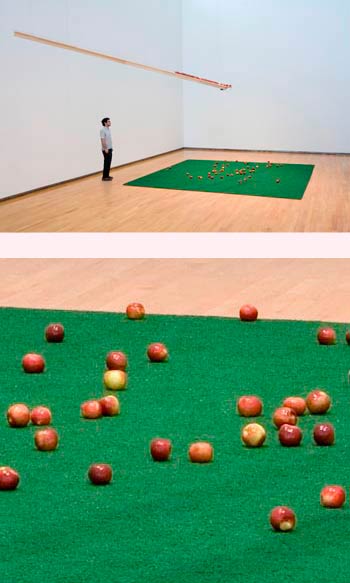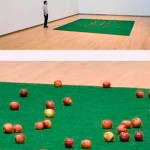By JON PETRO
"Spencer Finch: What Time Is It on the Sun?" now on display at Mass MoCA, consists of over 40 groupings of art, 160 individual pieces in total, four of which the press-release states as major new works. One such work, Composition in Red and Green, is comprised of a long, motorized, chute device, maybe 30 feet in length, suspended from the ceiling on an angle and loaded with fresh apples that are dropped every few minutes onto a 20 foot square of AstroTurf. Ok, I guess I'm supposed to be profoundly moved by the title's implication that this object has the ability to produce an unthinkable number of variations over the life-expectancy of the exhibition. But it's the smell of rotten apples that I'm left with, literally.
It is a fairly common occurrence to enter Mass MoCA’s galleries to discover signage stating, "object of art temporarily not functioning,” and his happens to be the case with Composition in Red and Green. I can’t imagine who at Mass MoCA thought it would be a good idea to leave this work up and not repair it. It is important to note that this issue is a contemporary one: a defective finished product of art that ultimately diminishes the quality of a museum experience, but also calls into question whether or not this artifact is actually a work of art. Is a broken conceptual work of art, still a work of art? If I don’t witness the work of art in process will I still be able to conceptualize it? With its function no longer following its form, is it conceptually insolvent? This Newtonian apparatus has all the trappings of art by association - it’s in a Museum, it belongs to someone's collection of art, and it provokes me to think: I contemplate just how poorly this object of art is made, I wonder if the artist feels any sense of responsibility, or if the artist really cares about it at all.
Is it contrast or contradiction? In Susan Gross's essay "Spencer Finch Alchemy," Gross states, "contrary to what one might expect, Finch's efforts toward accuracy - the precise measurements he takes under different conditions and at different times of day - resist, in the end, a definitive result or single empirical truth about his subject." At first I thought this idea was conceived to justify Finch’s syntax, which it does. It's definitely propaganda. The more I thought about this idea the less it appeared to be logical, it seemed to contradict itself. If your art is principally about the process why would you invest time in an endeavor that yields no results? Finch, in theory, could have just swept the floors of Mass MoCA and gotten the same results. It simply wouldn’t make any difference, so why is it a stipulation to believe it does, which is where the contradiction lies.
It wouldn’t be fair to expect me to write about art that isn’t visual. For me, conceptual art is all about 1917 and Duchamp. It is not the watered-down version where we witnessed the Young British Artists ascend to significant unimportance in the early 1990's when they used the idiom as a euphemism for the avant-garde. I understand and therefore respect the historical aspects of Conceptual Art, which is the idea-based art of the 60's and 70's. Just imagine how treacherous it was for an artist to abandon the visual components of fine art to maintain the all too necessary style of the cutting edge. It is this premise, the absence of a strong visual component, that makes my daily inquisitive lust for art wobble with boredom. In the same breath I am completely at a loss as to how this idea of conceptual art manages to leave little droppings of artifacts for my viewing displeasure. I am quite aware of how this argument sounds like George Dickie's idea of the Institutional Theory of Art, which in a nutshell is defined as art existing due to its position in the art world. But if it is indeed conceptual art, why is it trapped in an object that has no inherent aesthetic value? It is, after all, a visual art experience, no? Museums of Contemporary Art are foundations for the temporal display of objects of art. So is this type of museum the best environment for these artifacts that lack a visual component?
I am under the firm belief that the work of Spencer Finch is neither exciting, nor innovating. Where I venture next will come as no surprise, is Finch’s art good? No, not in my opinion, but it is art - just not the type of art I find compelling. I put an honest amount of thought into the ideas expressed by Finch in this exhibition, at the very least equal to the amount Finch applied to his craft. I was so dissuaded by the idea of contemporary conceptual art that: if I never saw another hypothetical work of art again, I’d be fine.
- Spencer Finch, Composition in Red and Green, installation view and detail, 2000.
- Spencer Finch, Sunlight in an Empty Room (Passing Cloud for Emily Dickinson, Amherst, MA, August 28, 2004), 2004.
- Spencer Finch, Night Sky (Over the Painted Desert, Arizona, January 11, 2004), (foreground) 2004 and 102 Colors from My Dreams, 2000-2002.
"Spencer Finch: What Time Is It on the Sun?" is on view through Spring 2008 at Mass MoCA in North Adams MA.
All images are courtesy of the artist and Mass MoCA.







